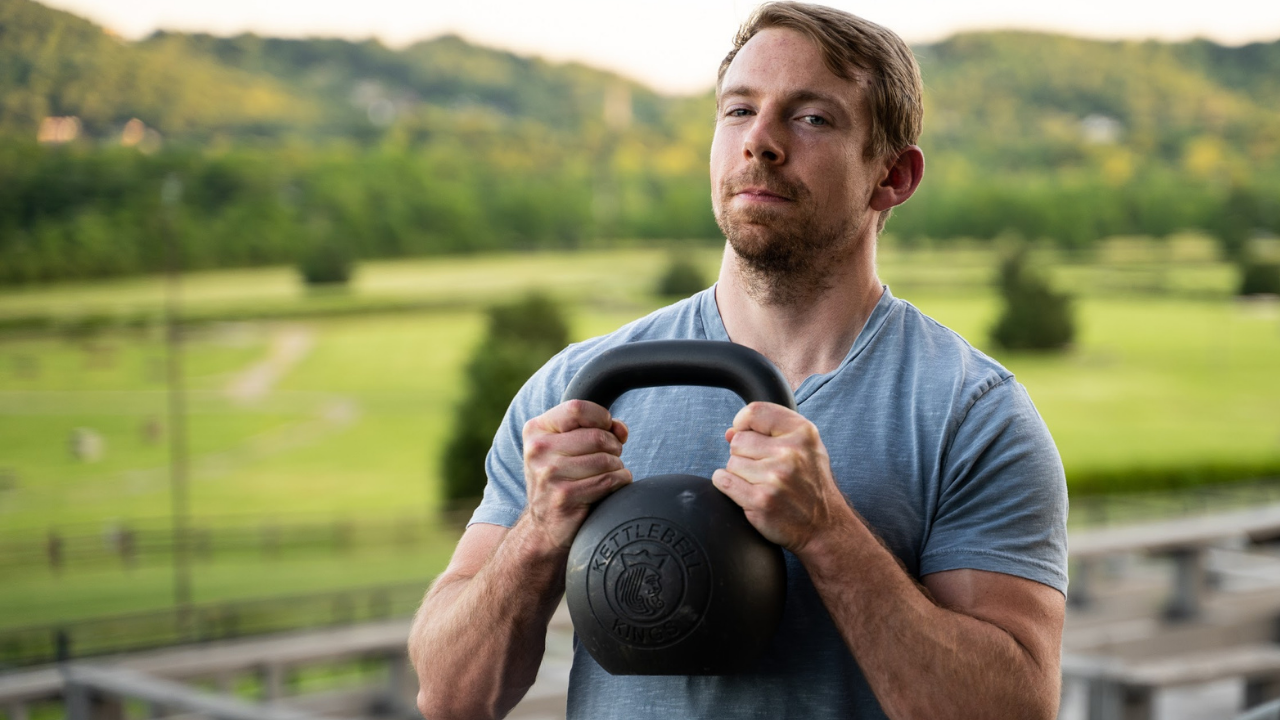Kettlebells have been pretty hard to find this year.
Quarantine mandates set off an unprecedented run on home fitness equipment that left manufacturers struggling to keep up with demand.
Thankfully, it looks like most retailers are catching up on stock… but Black Friday is quickly approaching.
It seems the rest of the world is catching on to what us fitness nerds have known all along – a good set of kettlebells at home is worth its weight in gold, or at least a monthly gym membership.
If you’ve been thinking about starting or upgrading your home gym (whether that’s a corner of your bedroom, or a full two-car garage), this article will tell you exactly what you need to know about kettlebells, how many to get, where to buy them, and how to put them to good use.
And if you already have a bell or two, I’ll share some ideas on how and why to expand your collection.
Let’s dive in.
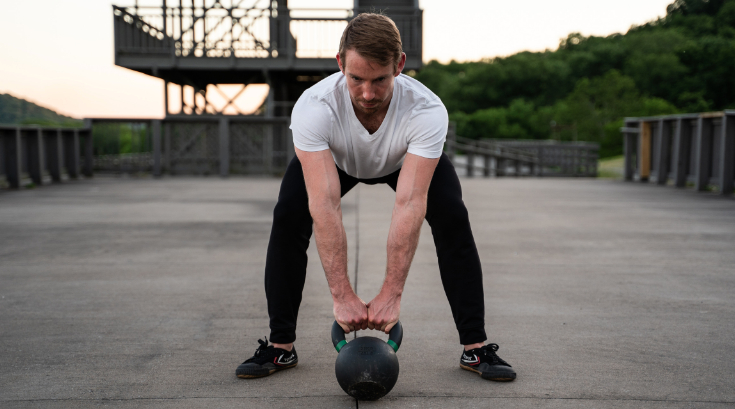
Why use kettlebells?
A kettlebell is a free weight with a simple design – a flat-bottomed cannonball with a handle up top.
And when it comes to getting effective strength and cardio workouts done at home, a kettlebell just can’t be beat.
The design of the kettle offers three distinct advantages over it’s “bell” brothers, the dumbbell and barbell:
1) Kettlebells take up less space
Kettlebells don’t need a rack for storage or require extra weight plates. They sit flat on the floor (no rolling around) and the compact design means no wasted space.
In fact, my own home-use set of 9 bells fits on single welcome mat.
2) A single kettlebell is extremely versatile
To get the most out of a barbell, you’ll need lots of plates (a great benefit of barbell training is the ability to increase weight in micro jumps), a squat rack, and a bench. If deadlifting heavy or Olympic lifting, a platform is mandatory.
Likewise, dumbbells are a great training tool, but you’ll need a lot of them to get an decent full-body workout. A pair of 15 lb dumbbells might be all your shoulders need, but won’t do much for your legs.
Armed with some savvy training knowledge (you will be by the end of this article), you’ll be able to get a great total-body workout with only 1-3 kettlebells, no matter your strength level.
Plus, you never really outgrow the lighter bells. There are unique uses for each size. (I still use the first kettlebell I ever bought, 10 years later)
3) Kettlebells are beginner-friendly.
As a fitness coach, my goal is to get new clients feeling comfortable and confident while lifting weights and learning basic movement patterns.
Squats and deadlifts, in particular, are key exercises that many new lifters struggle with or are intimidated by. Jumping right into the barbell variations is rarely a good idea.
Again, the design of the kettlebell comes to the rescue and makes learning these moves a cinch. Because the bell’s center of mass is directly under your grip, deadlifts fly up naturally without much cueing.
In fact, I regularly have grandmas lift 70-100 lb kettlebells on their first session. They insist the KB feels easier than a suitcase half as heavy. Kettlebell squats, likewise, seem to correct many technique issues almost automatically.
What are kettlebells good for?
The kettlebell is the Swiss Army Knife of fitness – you can do just about anything with it.
It’s not a magic pill or silver bullet. You still have to put in the work, and do so consistently, to see results. But no matter your goal, or where you’re starting from, kettlebell training can transform your body and performance in ways you never thought possible.
Kettlebells for Weight Loss
Losing body fat and maintaining a lean physique comes down to controlling calories through nutrition and training. Kettlebell training offers many powerful ways to rev your metabolism and burn a mountain of calories in very little time.
When it comes to getting the most fat-burning bang for your buck, the swing is king.
The kettlebell swing is a hip hinge dominant movement, like a deadlift or box jump. This means each and every rep engages the posterior chain muscles of the hamstrings, glutes, back, and lats (plus lots of core if you do them right).
When working all these large muscle groups dynamically at the same time, your heart rate jumps and you enjoy a calorie burn akin to a sprint (without the impact on the joints).
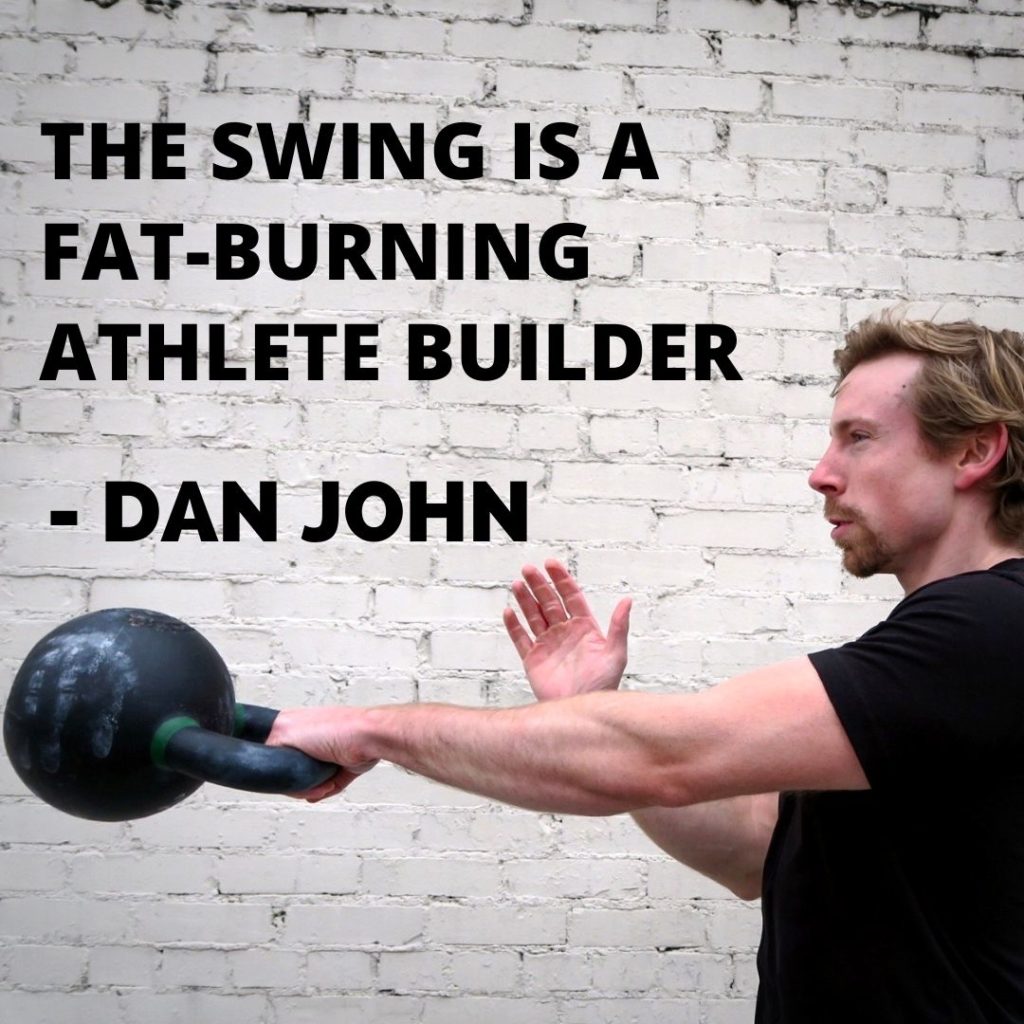
Of course, any exercise can help you lose weight, but the kettlebell swing (and its big brother – the snatch) is a one-stop-shop for anyone looking for a simple and proven approach to cut body fat while building functional strength.
Kettlebells for Strength
As mentioned above, kettlebells are a great way for beginners to learn the fine art of strength training.
The foundational kettlebell lifts cover all the major movement patterns while developing athleticism and a strong mind-muscle connection.
Squats and swings build powerful and mobile hips – the keystone for every truly strong athlete.
Row and press variations (especially bottoms-up) build resilient shoulders and a guaranteed ticket to the gun show.
The infamous Turkish Get-Up is a classic hybrid lift that will revolutionize how you feel and use your core.
Kettlebells are known for boosting strength and breaking plateaus for even the most seasoned strength athletes. This “what the hell” effect takes place when, after using kettlebells for a while, new reserves of strength and skill suddenly appear to demolish stubborn old personal records. This is why I always program some amount of kettlebell training for my powerlifting clients.
Kettlebells for Endurance
Endurance is highly dependent on the sport, activity, or skill being performed.
For example, a long-distance trail runner might flounder after a couple laps in the pool… and a swimmer might find cycling tortuous. This is why triathlons are so tough and require specialized training.
Kettlebell training is optimal for a type of endurance called general physical preparedness (GPP).
In simple terms, by working the entire body with higher reps and moderate weight, you increase overall work capacity.
GPP is the generalist approach to cardio and conditioning.
You won’t be the absolute best in any one field, but you’ll be in great shape and ready to handle a broad range of activities – from pickup basketball to packing a U-Haul.
The benefits of kettlebells run deep and this is just a cursory look at what smart training offers.
How Many Kettlebells Do I Need For A Home Gym?
Over the years, I’ve invested in nearly 30 kettlebells (a hodgepodge of different sizes, styles, and brands).
Yet the handful of bells I keep in my living room are enough to equip most any workout, even with a training partner or two.
You see, 80% of your kettlebell training can be covered with just 3 bells…
- A lighter bell for upper-body lifts like presses, get-ups, halos, windmills, and arm-bars… as well as for learning advanced lifts like cleans and snatches.
- A heavier bell for deadlifts, swings, carries, and squats.
- A moderate bell to progress in your upper body strength and advanced lifts. Plus, a medium weight is ideal for kettlebell complexes – the stringing together of multiple lifts into a larger continuous set.
Now the question is which 3 bell sizes do you need?
What Size Kettlebells Do I Need?
Most kettlebells come in 4-kilogram increments.
A “full set” runs the scale like so – 8kg, 12kg, 16kg, 20kg, 24kg, 28kg, and 32kg.
Kettles come much heavier than these (the 48kg “Beast” is the cherry on top most collections), but we’re focusing on the sizes with the most value for beginners.
The nearly 9-pound jump between sizes is another quirk that makes kettlebell training unique.
It’s a creative constraint.
Without the option of increasing weight in small steps, you are forced to make progress in various other ways with the same bell – volume (more reps), density (less rest), and variations (there are dozens of ways to perform a lift) are the big ones.
Your strength and physical skills really blossom with this approach of getting everything you can out of a single kettlebell.
Unfortunately, I have to make broad generalizations when it comes to making kettlebell size recommendations.
I provide more context so you can make the best choice for yourself, but here’s the thing…
No matter your sex or fitness level, nearly every bell size has great value and there’s plenty of overlap in the recommendations anyway.
After all, there are only so many kettlebell sizes to choose from.
I’ve broken recommendations into two sets of three bells.
Your 1st set of kettlebells should cover all your training needs for your first six months and most of your needs for life.
A good first set of bells should include a weight that’s light enough to safely use with overhead work, a weight heavy enough to tax the posterior chain with swings and deadlifts, and something in between.
Look at getting a 2nd set after you’ve been training consistently for six months and have a confident grasp on the fundamentals.
A good second set of bells should include a heavy weight to cover your swing and squat needs (you’ll probably never need anything bigger) and completes your first pair of weights for double kettlebell work.
Kettlebell Weights for Women
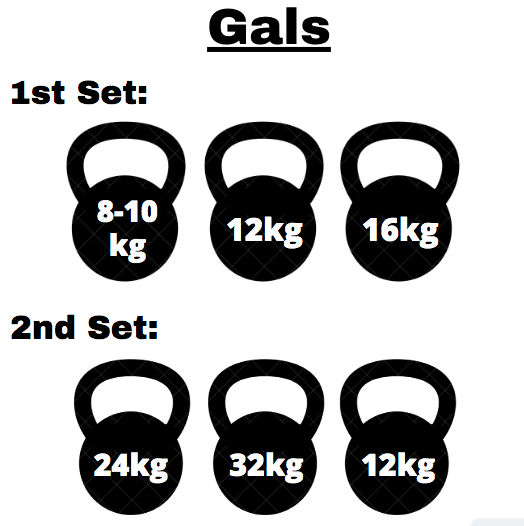
Your lightest kettlebell should be something you can confidently press overhead for 5 reps. Typical sets begin at 8 kg (18 lb), but 10 kg (22 lb) might be a better fit if you’re on the stronger side. Plus, it makes that first jump in weight up to 12 kg much more manageable.
The set rounds out with 12 kg (26 lb) and 16 kg (35 lb). These are your “bread ‘n butter” weights that will serve you well in both lower and upper body training for life.
Swing and squat strength tends to grow faster compared to the upper body lifts and is why I suggest jumping up to the 24 kg (53 lb) and 32 kg (70 lb) bells.
Finally, the extra 12 kg will give you a great pair for double kettlebell workouts. Of course, you might want this first pair to be lighter (8-10 kg) or heavier (16 kg) depending on your strength level.
Kettlebell Weights for Men
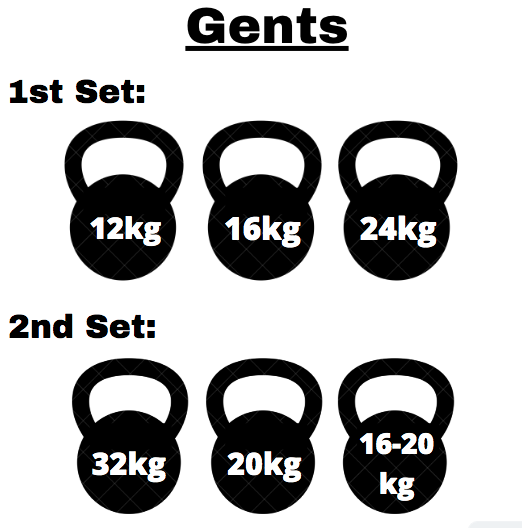
We follow the same line of reasoning for the fellas, with an assumption of more general upper body strength.
As you can see, most of the weight recommendations end up the being the same. Again, this is why a core set of bells can be used by just about anyone to great effect.
We start with 12 kg as even the brawniest of dudes will get good use from one for mobility-oriented lifts like arm bars and windmills as well as advanced get-up and bottoms-up press work.
While the 24 kg will be your go-to weight for many upper and lower body lifts, the 16 kg is a handy option for higher volume workouts and technique practice.
Looking forward to the next set, most guys will get great use out of the 32 kg for swings and maybe even presses.
From here, I like to recommend a pair of 20 kg (44 lb) kettlebells as this seems to be a sweet spot for double bell complexes. Of course, depending on your strength progress, you could snag another 16 kg or 24 kg to complete a lighter or heavier pair.
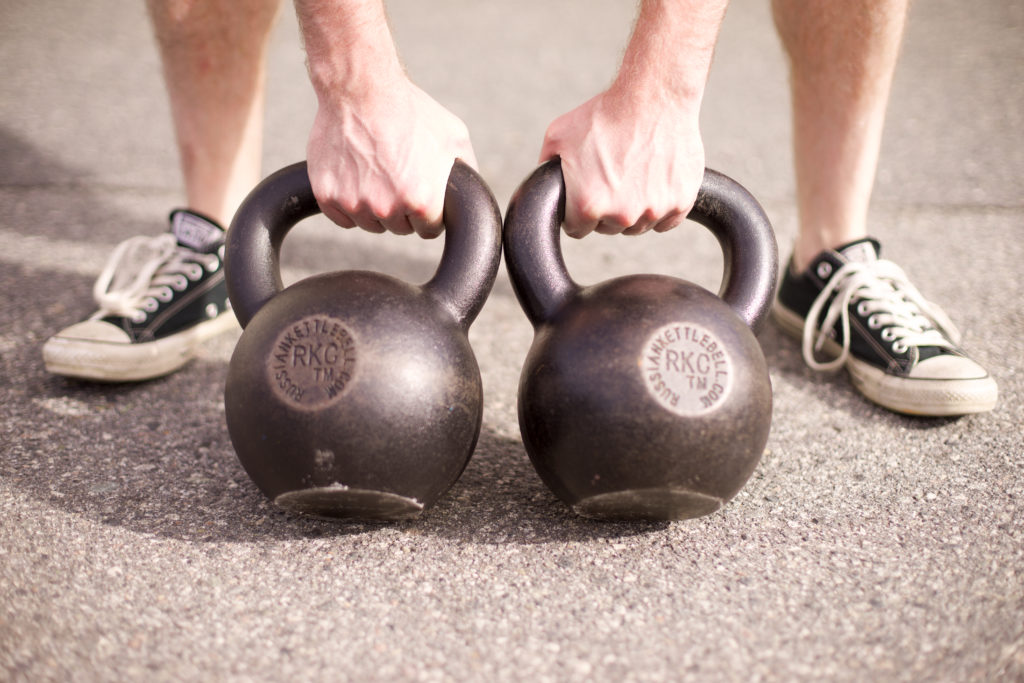
Where To Buy Kettlebells
With the rise of at-home functional fitness, more and more retailers are jumping into the kettlebell game.
Unfortunately, many are simply cashing in on the hype as the market becomes flooded with cheaply-made bells. Plus, most weights you see in stores are barely heavy enough to hold a door open, much less be of any use for training.
The good news is there are plenty of trusted online sellers that offer quality kettlebells.
Here’s my top-5 list of recommended kettlebell brands and merchants based on my own personal use (all links are affiliate):
To be fair, each brand of bell will differ slightly in dimensions, casting, and finish used.
Like a pair of jeans, some will fit your body and preferences better than others. Do some research and, if possible, get your hands on a few kettlebells at a local gym first.
But don’t rack your brain.
Really, you can’t go wrong with any of the above recs. They won’t run out of batteries, there’s no monthly fee, and will last a lifetime.
